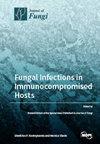Insight into Virulence and Mechanisms of Amphotericin B Resistance in the Candida haemulonii Complex
IF 4.2
2区 生物学
Q2 MICROBIOLOGY
引用次数: 0
Abstract
The Candida haemulonii complex includes emerging opportunistic human fungal pathogens with documented multidrug-resistance profiles. It comprises Candida haemulonii sensu stricto, Candida haemulonii var. vulnera, Candida duobushaemulonii, Candida pseudohaemulonii, and Candida vulturna. In recent years, rates of clinical isolation of strains from this complex have increased in multiple countries, including China, Malaysia, and Brazil. Biofilm formation, hydrolytic enzymes, surface interaction properties, phenotype switching and cell aggregation abilities, extracellular vesicles production, stress response, and immune evasion help these fungi to infect the host and exert pathological effects. Multidrug resistance profiles also enhance the threat they pose; they exhibit low susceptibility to echinocandins and azoles and an intrinsic resistance to amphotericin B (AMB), the first fungal-specific antibiotic. AMB is commonly employed in antifungal treatments, and it acts via several known mechanisms. Given the propensity of clinical Candida species to initiate bloodstream infections, clarifying how C. haemulonii resists AMB is of critical clinical importance. This review outlines our present understanding of the C. haemulonii complex’s virulence factors, the mechanisms of action of AMB, and the mechanisms underlying AMB resistance.洞察血色念珠菌复合物的毒性和两性霉素 B 抗性机理
血液念珠菌复合菌群包括新出现的机会性人类真菌病原体,具有记录在案的多重耐药性特征。它包括严格意义上的血色念珠菌、血色念珠菌变种、杜布沙血色念珠菌、假血色念珠菌和vulturna念珠菌。近年来,在包括中国、马来西亚和巴西在内的多个国家,从这一复合菌株中临床分离出的菌株比率有所上升。生物膜的形成、水解酶、表面相互作用特性、表型转换和细胞聚集能力、胞外囊泡的产生、应激反应和免疫逃避有助于这些真菌感染宿主并产生病理效应。它们对棘白菌素和唑类药物的敏感性较低,对两性霉素 B(AMB)--第一种真菌特异性抗生素--具有内在抗药性。AMB 通常用于抗真菌治疗,它通过几种已知的机制发挥作用。鉴于临床念珠菌有引发血流感染的倾向,弄清血念珠菌如何抵抗 AMB 在临床上至关重要。本综述概述了我们目前对血念珠菌复合体毒力因子、AMB 作用机制和 AMB 耐药性机制的理解。
本文章由计算机程序翻译,如有差异,请以英文原文为准。
求助全文
约1分钟内获得全文
求助全文
来源期刊

Journal of Fungi
Medicine-Microbiology (medical)
CiteScore
6.70
自引率
14.90%
发文量
1151
审稿时长
11 weeks
期刊介绍:
Journal of Fungi (ISSN 2309-608X) is an international, peer-reviewed scientific open access journal that provides an advanced forum for studies related to pathogenic fungi, fungal biology, and all other aspects of fungal research. The journal publishes reviews, regular research papers, and communications in quarterly issues. Our aim is to encourage scientists to publish their experimental and theoretical results in as much detail as possible. Therefore, there is no restriction on paper length. Full experimental details must be provided so that the results can be reproduced.
文献相关原料
| 公司名称 | 产品信息 | 采购帮参考价格 |
|---|
 求助内容:
求助内容: 应助结果提醒方式:
应助结果提醒方式:


